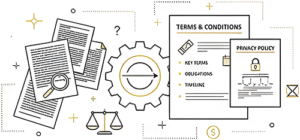More than “I agree”: How Legal Design Thinking changes terms of use and privacy policy?
Redesign of contracts for the 21st century: Contracts everyone understands

Do you remember the last time you read the entire Terms of Use or Privacy Policy of an application? Probably not. These documents are often long, complex, and filled with legal jargon, creating a barrier between you and the service you use. Although they are essential for protecting your rights, they have become little more than “dead letters.”
But what if these documents were clear, transparent, and easy to understand? That is exactly the goal of Legal Design Thinking (LDT) when it comes to digital agreements. We not only write these documents, but also design them with you in mind.
Redesign of digital agreements: From complicated to understandable
Instead of creating confusion, your Uslovi korišćenja, Politika privatnosti and cookie rules can become tools for building trust. We do this in the following ways:
1. Visual transformation: We use visual elements such as infographics, icons, and simple tables to clearly present key information. For example, instead of a long list of texts about data collection, you can have icons that show what we collect (e-mail, location, browsing habits) and why we do it.
2. Clear language: We replace legal jargon with simple, everyday language. Instead of “data will be used for anonymized statistical analyses”, we use “your data helps us improve our service”. This does not change legal validity, but it drastically improves comprehensibility.
3. Interactive elements: Instead of static PDF documents, we create interactive online versions. By clicking on a certain section (e.g. “Kolačići”), a short, clear summary opens. Users can easily find the information they are interested in without searching through hundreds of pages.
Practical example from practice
Imagine you are developing a popular mobile application.
Traditional approach: Your user has to go through dozens of pages of text full of legal language in order to agree to the terms. Many will simply click “Slažem se” without reading.
LDT approach: Upon first login, the user is presented with three clear screens. Each screen has a title (“Your data”, “What you can expect?”, “How we use cookies?”), accompanied by an icon and a short, simple explanation. Only then does the user have the option “I agree”. In this way, the user is informed, and you meet legal obligations in a transparent manner.
Wisdom of design: Ethics as the key to success
Ultimately, LDT is not just about user experience or marketing. It is a reflection of an ethical approach to law. Instead of lawyers relying on confusing documents to “cover themselves”, we offer solutions that align with trust.
When the Uslovi korišćenja are clear, you not only protect your business, but also show respect for the user. In today’s world, where transparency is demanded, this is the strongest asset you can have.
Our goal is to create transparency and trust. When your users understand what they are accepting, they feel safer and are more likely to use your service. Ultimately, LDT turns boring legal documents into powerful tools for marketing and loyalty.
Other blogs
From “Greenwashing” to Verifiable Compliance – How to Visualize ESG Reporting?
ESG (Environmental, Social, and Governance) reporting is no longer just a nice addition…
Global Compliance: How to Design Rules for Data Flow Across Different Jurisdictions (EU/US)?
Today's business is global, and data knows no borders. However, the laws are still local….
